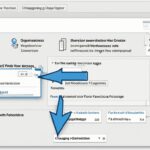Table of Contents
In today’s digital landscape, attention to detail plays a vital role in establishing a strong online presence. One often overlooked aspect that can make a significant impact on your website’s branding is the favicon. A favicon is a small icon that appears in the browser tab next to your site’s title. It may seem like a minor element, but it contributes to brand recognition and enhances user experience.
If you’re looking to change your WordPress favicon, you’re in the right place. In this article, we will provide a step-by-step guide on how to update your favicon, helping you elevate your website’s visual appeal.
Key Takeaways
- Updating your WordPress favicon is important for branding and recognition.
- A favicon enhances your website’s visual appeal and contributes to a professional online presence.
- Follow our step-by-step guide to change the favicon in your WordPress site.
- Consider best practices for favicon design to create a visually appealing icon.
- Refreshing your favicon can give your website a more cohesive and professional look.
Understanding the Role of Favicon in WordPress
Before diving into the process of changing your WordPress favicon, it’s essential to understand the pivotal role it plays in your website’s branding and recognition. A favicon, short for favorite icon, is a small image file that appears in the browser tab next to your website’s title.
While it may seem like a small detail, the favicon has a significant impact on how your website is perceived. It serves as a visual representation of your brand and helps users identify and recognize your site amidst a sea of tabs.
Branding:
By incorporating your logo or a distinct image into your favicon, you reinforce your brand identity. Consistency in branding across all touchpoints helps establish trust and familiarity with your audience. When they see your favicon, they can immediately associate it with your business, products, or services.
Recognition:
A well-designed favicon enhances recognition and makes your website memorable. When users bookmark or save your site, the favicon appears alongside the link. By having a visually appealing favicon, you increase the chances of users returning to your site, as they can easily identify it among their bookmarks or saved links.
“A favicon not only enhances the visual appeal of your site but also contributes to a consistent and professional online presence.”
Furthermore, when users have multiple tabs open, a favicon helps them quickly distinguish between different websites. It provides a visual cue, making navigation more effortless and improving user experience.
Benefits of a favicon in WordPress:
- Improves brand recognition
- Elevates the visual appeal of your website
- Increases user engagement and trust
- Enhances user experience and navigation
Now that we understand the importance of favicons in WordPress, let’s explore the step-by-step process of changing your favicon in the next section.
Steps to Change the Favicon in WordPress
In this section, we will explore the step-by-step process of changing the favicon in WordPress. By following these simple instructions, you can revamp your site’s branding with a fresh and updated favicon.
- Login to your WordPress admin panel: To get started, log in to your WordPress website using your admin credentials. This will take you to the WordPress dashboard.
- Navigate to the Appearance menu: Once you’re logged in, find the “Appearance” tab in the left-hand menu of the WordPress dashboard and click on it. This will open a dropdown menu.
- Select “Customize” option: In the “Appearance” dropdown menu, click on the “Customize” option. This will take you to the WordPress Customizer interface.
- Open the Site Identity settings: Inside the WordPress Customizer, locate and click on the “Site Identity” option. This will open the site identity settings panel.
- Upload your new favicon: In the site identity settings panel, find the “Site Icon” or “Favicon” field. Click on the “Select Image” button to upload your new favicon from your computer. Make sure your favicon meets the recommended size and format requirements.
- Save your changes: Once you have uploaded your new favicon, click on the “Save & Publish” button at the top of the WordPress Customizer to save your changes. Your new favicon will now be visible on your website.
Changing the favicon in WordPress is a straightforward process that can be completed in just a few simple steps. By following these instructions, you can change your website’s favicon and give it a fresh and updated look. Now let’s take a look at some best practices for designing an effective favicon.
Best Practices for Favicon Design
When designing your favicon, it’s important to keep in mind some best practices to ensure its visual appeal and functionality. Consider the following guidelines:
- Keep it simple: Favicon is a small icon, so it’s crucial to keep your design simple and easy to recognize even at small sizes.
- Showcase your branding: Your favicon should reflect your brand identity and be consistent with your website’s overall design.
- Choose a recognizable symbol or letter: Opt for a symbol, letter, or simple graphic that represents your brand and is easily identifiable.
- Test its visibility: Make sure your favicon is visible and recognizable against different background colors and in different browsers.
Following these best practices will help you create a visually appealing favicon that enhances your website’s branding and improves user experience.
![]()
Now that you know how to change the favicon in WordPress and the best practices for favicon design, you can confidently update your site’s branding with a new and improved favicon.
Best Practices for Favicon Design
A well-designed favicon can have a significant impact on your website’s overall appearance. It not only enhances the visual appeal but also contributes to a cohesive and memorable brand identity. To ensure your favicon represents your brand effectively and enhances the user experience, consider the following best practices:
- Keep it Simple: A favicon is a small icon, typically measuring 16×16 pixels or 32×32 pixels. To ensure it remains clear and recognisable, opt for a clean and simple design. Avoid including excessive details or complex images that may appear blurry or distorted at such a small size.
- Reflect Your Brand Identity: Your favicon should align with your brand’s visual identity. Consider incorporating elements from your logo, such as colours, shapes, or initials, to maintain consistency across all touchpoints.
- Use High-Quality Graphics: Even though the favicon is small, it’s essential to create it with high-resolution graphics. This ensures that it appears crisp and professional across different devices and browsers.
- Test for Cross-Browser Compatibility: Different browsers may render favicons differently. Test your favicon across popular browsers to ensure consistency and optimal visibility.
- Choose a Recognisable Image: A favicon is meant to be a quick identifier for your website. Select an image or symbol that is easily recognisable and representative of your brand.
- Avoid Text and Complex Symbols: As favicons are small and square-shaped, text and intricate symbols may become illegible or lose their intended meaning. Stick to simple shapes, icons, or initials to create a clear and impactful favicon.
- Consider Accessibility: Ensure that your favicon remains accessible to users with visual impairments. Use the alt attribute when inserting the favicon image to provide a descriptive text alternative.
By following these best practices, you can create a visually appealing and recognisable favicon that enhances your website’s overall appearance and reinforces your brand identity.
Conclusion
Updating your WordPress favicon is a simple yet effective way to refresh your site’s branding. By following the step-by-step guide provided in this article, you can easily change your favicon and give your website a more professional and cohesive look.
Remember to consider best practices for favicon design to ensure a visually appealing and memorable icon. A well-designed favicon can make a significant impact on your website’s overall appearance, contributing to a consistent and professional online presence.
Elevate your brand’s online presence today by updating your WordPress favicon. Take advantage of this small but essential element to create a cohesive brand identity and enhance recognition. With a fresh and updated favicon, you can make a lasting impression on your website visitors and reinforce your brand’s visual appeal.
FAQ
Why is it important to update the WordPress favicon?
Updating the WordPress favicon is important for branding and recognition purposes. The favicon appears in the browser tab next to your website’s title and contributes to a consistent and professional online presence.
How does the favicon enhance my website’s branding?
The favicon enhances your website’s branding by providing a visual element that represents your brand. It appears in the browser tab, bookmarks, and history, ensuring that your brand is easily identifiable and memorable.
How can I change the favicon in WordPress?
To change the favicon in WordPress, follow these steps:
1. Log in to your WordPress dashboard.
2. Navigate to Appearance > Customize.
3. Look for the ‘Site Identity’ or ‘Site Identity & Logo’ section.
4. Click on the ‘Select Image’ button or similar.
5. Choose or upload the image you want to use as your favicon.
6. Save your changes.
After completing these steps, your new favicon will be displayed across your WordPress website.
What are some best practices for favicon design?
When designing a favicon, consider the following best practices:
1. Keep it simple: Use a clear and uncomplicated design that can be easily recognized at small sizes.
2. Maintain brand consistency: Ensure that the favicon aligns with your brand’s visual identity and color scheme.
3. Use a recognizable symbol or initial: If your brand has a recognizable symbol or initial, consider incorporating it into the favicon.
4. Consider contrast: Make sure the favicon stands out against different browser backgrounds.
5. Preview and test: Preview your favicon in various browsers and devices to ensure it looks good and is legible.
Can I use any image as my favicon?
It is recommended to use a square image with dimensions of at least 512×512 pixels for optimal results. Avoid using complex images or logos that may not be easily recognizable at small sizes. Additionally, ensure that the image format is supported by web browsers, such as .ico, .png, or .svg.











